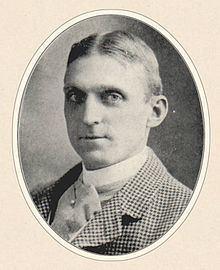Nationality American Parent(s) Walter CaryJulia Love | Occupation Architect | |
 | ||
Spouse(s) Allithea Birge(m. 1908; her death 1918) Died 1945, Buffalo, New York, United States Structures Buffalo and Erie County Historical Society | ||
George Cary (1859– May 5, 1945), was a major American architect from New York State known for his designs for the Pan American Exposition of 1901 in Buffalo, New York.
Contents
Early life and education
George Cary was born in 1859, the son of prominent Buffalo resident, Dr. Walter Cary (1818-1881) and Julia Cary (née Love). George was the grandson of Trumbull Cary (1787-1869), a New York State Senator and Assemblyman.
George was one of seven children: Trumbull Cary (1849-1913), Thomas Cary (1851-1921), Charles Cary (1852-1931), who in 1879 married Evelyn Rumsey (1855-1924), Jennie Cary (1854-1943), Walter Cary Jr. (1857-1933), George Cary (1859-1945), and Seward Cary (1862-1948). His nephew, Charles Cary Rumsey (1879–1922), through his sister Jennie and brother-in-law Laurence D. Rumsey (1849-1917), married Mary Harriman, daughter of millionaire railroad executive E. H. Harriman and Mary Williamson.
Cary attended and graduated from Harvard and the Columbia School of Architecture. After graduating from Columbia, Cary spent a brief apprenticeship with McKim, Mead and White in New York City. Directly after that, he went to Paris and studied at the Ecole des Beaux-Arts from 1886 until 1889, the first Buffalonian to do so.
Career
In 1891, he returned to Buffalo and set up practice. In the mid-1890s, Cary redesigned some rooms in the Ansley Wilcox House, which later became known as Theodore Roosevelt Inaugural National Historic Site as it was the site where Theodore Roosevelt took the oath of office as President of the United States on September 14, 1901 after the assassination of William McKinley at the Pan-American Exposition of 1901.
When the Exposition came to Buffalo, Cary became one of the three local architects on the Board of Architects for the Exposition and designed the Ethnology Building and the New York State pavilion for the Pan-American Exposition. The pavilion was the only permanent building created for the Exposition and later became the Buffalo Historical Society, then the Buffalo and Erie County Historical Society, and today is the Buffalo History Museum.
Personal life
In 1908, He married Allithea Birge, daughter of George K. Birge and Carrie Birge (Birge wallpaper and Pierce-Arrow cars). Cary designed features on their home at 460 Franklin Street in the Italianate style. Together they had:
Cary was a founder of the Beaux-Arts Institute of Design, served as president of the American Institute of Architects (and a member for 53 years), a director of the Albright Art Gallery, member of the Fine Arts Academy.
Allithea died in 1918 and he died in 1945, at eighty-six. Both are buried in Forest Lawn Cemetery in Buffalo.
